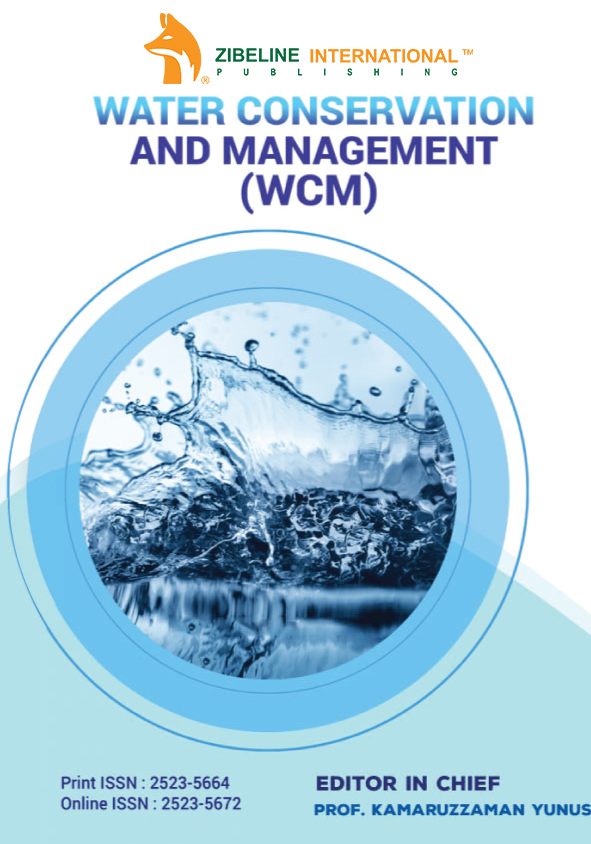OPTIMIZING THE REMOVAL EFFICIENCY OF CHROMIUM FROM TANNING PLANT EFFLUENT BY ADSORPTION METHOD WITH ACTIVATED CARBON CHAT STEMS (CATHA EDULIS) USING RESPONSE SURFACE METHODOLOGY
Journal: Water Conservation and Management (WCM)
Author: Tafere Aga Bullo, Yigezu Mekonnen Bayisa
Print ISSN : 2523-5664
Online ISSN : 2523-5672
This is an open access article distributed under the Creative Commons Attribution License CC BY 4.0, which permits unrestricted use, distribution, and reproduction in any medium, provided the original work is properly cited
Doi: 10.26480/wcm.01.2022.15.21
ABSTRACT
 Due to the high-water consumption of tanning plants, which produce many pollutants such as wastewater and heavy metals (chromium) as by-products enter the water bodies and pollute or harm the environment. This study investigated the removal of hexavalent chromium (VI) from wastewater using activated carbon Chat-Stem. Adsorption is a common treatment method using activated carbon because these heavy metals can be removed inexpensively, profitably, and efficiently. The approximate analysis of the moisture content of the chat stem is 6%, ash content of activated carbon is 17.35%, the volatile matter is 20.12%, fixed carbon content is 56.53%, and the bulk density of activated carbon is 0.392 g/cm3 at 360 ° C, which is in good agreement with the standard quality of activated carbon. As the process parameters changed, the increase of chromium removal efficiency was from 62.5% to 97.03%. The Maximum conditions of chromium removal efficiency were observed at the adsorbent dosage of 30 g/L, at pH of 4, and contact time at 180 minutes using the activated carbon chat stem to remove Cr from wastewater was found to be 97.03% with the desirability of 1 and the corresponding chromium removal efficiency optimized to 97.50%. The selected optimal conditions at the adsorbent dosage of 29.155 g/ml, at a PH of 3.32, and contact time of 174.651 min increasing the chromium removal efficiency to 97.83% with desirability 1 at Run 1. The surface of the chat stem before and after adsorption was characterized by FTIR. For short contact times, Langmuir and Freundlich’s adsorption isotherms were 0.9839 and 0.9995, respectively
Due to the high-water consumption of tanning plants, which produce many pollutants such as wastewater and heavy metals (chromium) as by-products enter the water bodies and pollute or harm the environment. This study investigated the removal of hexavalent chromium (VI) from wastewater using activated carbon Chat-Stem. Adsorption is a common treatment method using activated carbon because these heavy metals can be removed inexpensively, profitably, and efficiently. The approximate analysis of the moisture content of the chat stem is 6%, ash content of activated carbon is 17.35%, the volatile matter is 20.12%, fixed carbon content is 56.53%, and the bulk density of activated carbon is 0.392 g/cm3 at 360 ° C, which is in good agreement with the standard quality of activated carbon. As the process parameters changed, the increase of chromium removal efficiency was from 62.5% to 97.03%. The Maximum conditions of chromium removal efficiency were observed at the adsorbent dosage of 30 g/L, at pH of 4, and contact time at 180 minutes using the activated carbon chat stem to remove Cr from wastewater was found to be 97.03% with the desirability of 1 and the corresponding chromium removal efficiency optimized to 97.50%. The selected optimal conditions at the adsorbent dosage of 29.155 g/ml, at a PH of 3.32, and contact time of 174.651 min increasing the chromium removal efficiency to 97.83% with desirability 1 at Run 1. The surface of the chat stem before and after adsorption was characterized by FTIR. For short contact times, Langmuir and Freundlich’s adsorption isotherms were 0.9839 and 0.9995, respectively| Pages | 15-21 |
| Year | 2022 |
| Issue | 1 |
| Volume | 6 |

